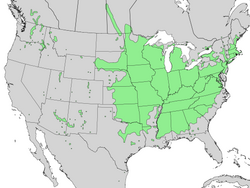| Rhus glabra | |
|---|---|
 | |
| Rhus glabra flowers | |
| Scientific classification | |
| Kingdom: | Plantae |
| Clade: | Tracheophytes |
| Clade: | Angiosperms |
| Clade: | Eudicots |
| Clade: | Rosids |
| Order: | Sapindales |
| Family: | Anacardiaceae |
| Genus: | Rhus |
| Species: | R. glabra |
| Binomial name | |
| Rhus glabra | |
 | |
| Natural range of Rhus glabra | |
Rhus glabra, the smooth sumac, [2] (also known as white sumac, upland sumac, or scarlet sumac) [3] is a North American species of sumac in the family Anacardiaceae.

